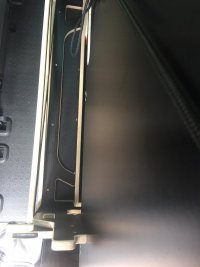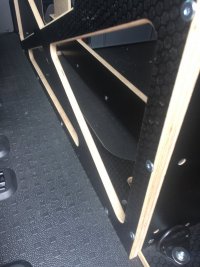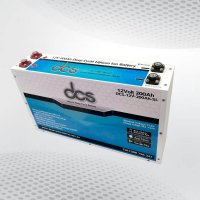So I'm planning my solar & 12V system & having read through a couple of other threads I would appreciate comments & suggestions on my plan...
I've done a demand calculation and it comes to 56Ah (672Wh) per day, this is dominated by the inverter/mini kettle giving a couple of brews first thing, followed by the fridge keeping those beers cool.
I plan to camp in the van for at 3 seasons, so early spring to late autumn; well once it's fully insulated & has acquired a diesel heater too.
Solar Panels;
I reckon on needing at least 250W to match that that demand once the days get shorter & then maybe I'll have to do with only one cuppa in bed before firing up a gas stove for the second in winter.
I like the idea of two panels in parallel as that will cope much better with being shaded than a single would, provided the shade in on one. so for that reason I plan to use longer/ narrower panels lengthways side by side on the roof, probably toward the front. I don't have any plans for a pop top so these will be onto the tin roof.
Really like the Photonics Universe with the round rear cable outlet and single 2 core cable, such a tidy look on the roof and better to wire up.
I am aiming for some stealthiness for free camping so minimal evidence on the roof is a plus.
This would be two 2x160W coming out at £620 or £1.94/W... ouch, but the reports from others do sound great!
438-160W-Black-Reinforced-semi-flexible-solar-panel-with-round-rear-junction-box-and-3m-cable-with-durable-ETFE-coating.html
Also like the Lensun LS-150FX2 again 2x 150W coming out at £380... only £1.24/W.
Black-flexible-solar-panel
Charge Controller;
I need to get rid of the VW split charge relay anyway so a DC to DC with solar input makes sense to me.
Also one which will trickle charge the starter battery also cuts down on extra bits & wires.
I have two single seats and the drivers will have a Sub in it someday so space will be at a premium.
I like the Renogy DCC50S, it has the voltage input headroom and power capacity in hand for those panel options.
dcc50s-12v-50a-dc-dc-on-board-battery-charger-with-mppt-new-version
I plan to look at the Ctek as well.
Battery;
Ordered the van with a 2nd battery so it currently has a Varta 75Ah AGM under the passengers seat.
I plan the "wear" this out (see below) before upgrading to a LipO of more like 150Ah.
I've had a quick look for slim units (2 x75Ah in parallel) which will fit just inside the front section of my Ovano XL bed/drawer which has a bit of a battery/electrics sized dead space.
Inverter;
I'll need at least 650W pure sine, for that mini kettle.
I've been through the energy & high discharge calcs for that and reckon I can get maybe 20mins from a fully charged battery (the one above) down to 11V; phew the mini kettle boils 500ml for a decent mug of tea in under 5mins...
I'm thinking of sticking with Renology as I can give it ac when on EHU and it'll switch over to that, only reverting when someone trims the EHU...
1000w-12v-to-230v-pure-sine-wave-inverter-with-ups-function
I would appreciate some steers on what to look out for on these...
EHU system;
I'll do this someday, so advice on ac to dc changing would be helpful...
I again had a quick look & did quite like the Victon blue smart fully sealed version so I can stick it under the van somewhere...
Thanks for reading this far and in advance for your thoughts....
Ian
I've done a demand calculation and it comes to 56Ah (672Wh) per day, this is dominated by the inverter/mini kettle giving a couple of brews first thing, followed by the fridge keeping those beers cool.
I plan to camp in the van for at 3 seasons, so early spring to late autumn; well once it's fully insulated & has acquired a diesel heater too.
Solar Panels;
I reckon on needing at least 250W to match that that demand once the days get shorter & then maybe I'll have to do with only one cuppa in bed before firing up a gas stove for the second in winter.
I like the idea of two panels in parallel as that will cope much better with being shaded than a single would, provided the shade in on one. so for that reason I plan to use longer/ narrower panels lengthways side by side on the roof, probably toward the front. I don't have any plans for a pop top so these will be onto the tin roof.
Really like the Photonics Universe with the round rear cable outlet and single 2 core cable, such a tidy look on the roof and better to wire up.
I am aiming for some stealthiness for free camping so minimal evidence on the roof is a plus.
This would be two 2x160W coming out at £620 or £1.94/W... ouch, but the reports from others do sound great!
438-160W-Black-Reinforced-semi-flexible-solar-panel-with-round-rear-junction-box-and-3m-cable-with-durable-ETFE-coating.html
Also like the Lensun LS-150FX2 again 2x 150W coming out at £380... only £1.24/W.
Black-flexible-solar-panel
Charge Controller;
I need to get rid of the VW split charge relay anyway so a DC to DC with solar input makes sense to me.
Also one which will trickle charge the starter battery also cuts down on extra bits & wires.
I have two single seats and the drivers will have a Sub in it someday so space will be at a premium.
I like the Renogy DCC50S, it has the voltage input headroom and power capacity in hand for those panel options.
dcc50s-12v-50a-dc-dc-on-board-battery-charger-with-mppt-new-version
I plan to look at the Ctek as well.
Battery;
Ordered the van with a 2nd battery so it currently has a Varta 75Ah AGM under the passengers seat.
I plan the "wear" this out (see below) before upgrading to a LipO of more like 150Ah.
I've had a quick look for slim units (2 x75Ah in parallel) which will fit just inside the front section of my Ovano XL bed/drawer which has a bit of a battery/electrics sized dead space.
Inverter;
I'll need at least 650W pure sine, for that mini kettle.
I've been through the energy & high discharge calcs for that and reckon I can get maybe 20mins from a fully charged battery (the one above) down to 11V; phew the mini kettle boils 500ml for a decent mug of tea in under 5mins...
I'm thinking of sticking with Renology as I can give it ac when on EHU and it'll switch over to that, only reverting when someone trims the EHU...
1000w-12v-to-230v-pure-sine-wave-inverter-with-ups-function
I would appreciate some steers on what to look out for on these...
EHU system;
I'll do this someday, so advice on ac to dc changing would be helpful...
I again had a quick look & did quite like the Victon blue smart fully sealed version so I can stick it under the van somewhere...
Thanks for reading this far and in advance for your thoughts....
Ian




